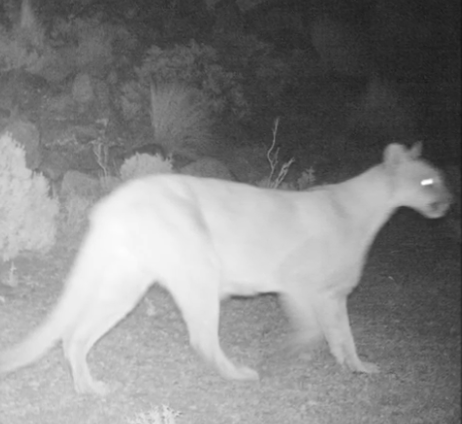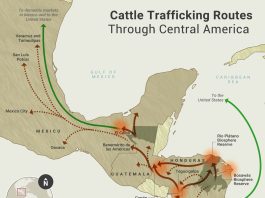Back in March of 2015, On Pasture published an article about Richard Turere, a 11-year-old Masai boy from Kenya, who invented a way to keep lions from nearby Nairobi National Park from attacking his village’s cattle. Using an old battery, a broken flashlight, an signal light switch from a motorcycle and a solar panel, he set up a randomly flashing light. The light made the lions think that someone was outside with the cattle and they stayed away. In the two years between Richard set up his flashing lights and his TED talk in 2013, none of his cattle were killed by lions. His invention is now being successfully used all over Kenya to scare away hyenas, leopards and even to keep elephants away from peoples’ farms.
What Works On Lions Can Work on Foxes, Wolves, Coyotes, Bears and Other Predators
I don’t know if Richard Turere and Ian Whelan have ever met, but they’ve had similar experience with flashing lights discouraging predators. Whelan, an Australian sheep farmer, was losing lambs to foxes, so in 2006, he invented what he calls “Foxlights” – a randomly flashing light that gives the illusion that someone is outdoors patrolling the pastures with a flashlight. After three years of 100% success, he decided to patent and sell his invention. In the video below, Ian introduces his invention in an Australian version of “Shark Tank.”
Foxlights have been deployed in the French Alps to deter grey wolves attacking sheep, and in Nepal to protect farmer’s yaks from snow leopards. In both cases the initial results were good. Nepalese herdsmen were delighted when their Foxlights scared off an intruding snow leopard, as shown in this video describing the project. In a report on French TV, following installation of Foxlights, the shepherds reported that they’d not lost a single sheep to wolves.

This anecdotal evidence is helpful, as is research by the Carnivore Coexistence Laboratory at the University of Wisconsin – Madison. In a randomized, controlled experiment, researchers found that Foxlights deterred pumas from attacking farmers’ alpaca and llama herds. Herds with Foxlights experienced zero losses to pumas as compared to 7 losses in control herds. But the research also revealed that the behavior of other predators might be changed as well, and not necessarily for the better. In this case, Andean foxes were more likely to attack herds with foxlights than the control herds (25 attacks to 15). Researchers wonder if the Foxlights attracted foxes in that habitat, but to date, research has not been done to resolve that question.
Should I Use Foxlights?
That’s a question that farmers and ranchers asked Wildlife Coordinator Kelli Hendricks, so she decided to run her own test to see if she could provide an answer.
Hendricks tested Foxlights on four different ranches in Marin and Sonoma Counties in Northern California during the lambing season of 2014, starting in December and ending in March 2015. She says, “The test sites ranged from a hobby farm with under a dozen sheep to ranches over 1000 acres with a few hundred sheep. All the sites already had some non-lethal tools in place, like guardian animals, night corrals or electric fencing. Nevertheless, three of the four were still suffering losses due to various circumstances like being down a guardian dog, or having fencing that needed work. The rancher who was not suffering losses was seeing increased signs of predators, plus their neighbors were losing animals, so they wanted to find a way to make their livestock even less inviting to predators.”

At the end of the season, not one lamb or sheep had been lost and the ranchers all purchased Foxlights. But Hendricks cautions that using Foxlights doesn’t mean you can just leave lambs in a field and they’ll be safe. She suggests using them during periods when livestock are most vulnerable, as they are when lambing, kidding or calving. She recommends not using them year-round as predators can habituate to them.
The bottom line is, a tool is only as effective as the person using it,” says Hendricks. “Ranchers have to use the right non-lethal tool for the right circumstance, and it has to be used the right way. Finally, attitude is everything. If a rancher is convinced that non-lethal tools either will or won’t work for them, they will probably be right.”
Thinking Creatively About Living With Predators
Sometimes the tools we have available keep us from thinking of new solutions. In Richard’s case, two tools common to farmers and ranchers in the U.S., guns and traps, weren’t available to him. Sometimes we’re inspired by unhappiness too. In Ian’s case he wasn’t happy with the results of guns and traps, and he didn’t like having to stay out all night. That led him to think of other options that might keep predators away.
This all reminds me that there is not one right answer, but multiple options that may be more suitable to different situations. If this article inspires you to come up with some new solutions, please share them with the On Pasture community!





I have a few goats. In the past I have had a goat here or there taken by a coyote. We also have bear visiting the property on game cam, and there are cougars in the area, although I’ve never seen one here on the place. We also have lots of bobcats, but they don’t seem to be interested in the goats.
I decided to put bells on all my goats so that I could locate them easily when they are in the blackberries. So, when my goats take off running, it makes a lot of ‘human’ noise. There are different size bells. May just be coincidence, but in the 3 years I’ve had bells on them, I’ve not lost a goat, and they’re out loose every night till around midnight. (I have no fences; they are always loose unless they are in the barn. But they are leary of venturing very far out into the woods. So they stay within about 500 feet of the house where the trees aren’t very thick.)
I zip tie the bells to their collars and soon recognize the tone of each goats bell.
I used Foxlights in areas with wolves and grizzly bears in several locations in western Montana. In one case a rancher had been losing calves to grizzlies. I put about twenty Foxlights around his calving pastures and the losses stopped. In another case we protected goats from wolves; and another, sheep from a mountain lion. Like all of the “gadget” type of non-lethal tools, they only work in relatively small pastures; and like all tools that rely on novelty, they probably only work for a relatively short time. Thus I recommend them in a context like a calving pasture or night pen (not randomly around out on the range).
Also, from a scientific standpoint, we can’t say for certain that a lack of predation is due to any particular tool as opposed to any other factor; but multiple lines of evidence are compelling.
Comments are closed.